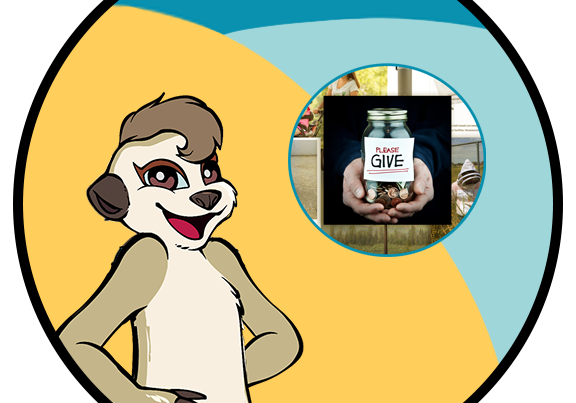
The Art of Campaign Storytelling
You’re sitting at your computer. You’re staring at a blank screen where your fundraising campaign story should be. And I know what you’re thinking:
“What the *bleep* do I put in this thing?!”
There is no ‘right’ or ‘wrong’ way to tell a story, but there are ‘more effective’ and ‘less effective’ ways. FundRazr has been around since 2009, and in that time, we have seen thousands of campaign stories. We compiled the most effective parts of these stories into seven steps that campaign owners can easily follow.
Seven steps to an effective fundraising campaign story
We have created a roadmap of six guidelines that will help tell your story – the right story – in a powerful way. This comes from years of working with individuals and organizations on crowdfunding campaigns and noting what factors lead to success.
You’ll have a reader at the beginning of the fundraising campaign story.
In the end, you’ll have a supporter.
I’ll use two examples to help explain these points:
Example 1: an animal shelter helping to take stray dogs from the street and put them into homes worldwide.
Example 2: a non-profit organization helping teenagers find access to mental health programs.
STEP 1—Start with a statement or rhetorical question that puts the reader in an agreeable, understanding frame of mind and intrigues them into reading more.
The mood is essential. You both need to be on the same page to turn a reader into a supporter. Having a supporter think, “Well, yes, absolutely,” or “I get your point” right at the start will increase their chances of reading further in the story.
Example 1: Where would we be without man’s best friend? Dogs are an essential part of human culture. They’re our companions, confidants, and sometimes even our eyes and ears.
Example 2: Navigating the world as a teenager is hard enough when dealing with tons of schoolwork and awkward hormones. It’s even worse when you’re also battling stress, anxiety, depression, or any other mental health issue.
STEP 2 – What is the main focus of this fundraising campaign story? The problem. Clearly state the problem you are trying to solve.
Every campaign is about solving a problem. You might have multiple issues working at once as an individual or organization, but this campaign is about this problem. Utilize microprojects to break a complex problem into multiple simpler ones. Identify the situation as the problem, avoiding blame toward any individual or group.
Also, identify the beneficiary, remembering there is always a ‘who.’ It could be one person, a group, or an animal. Emotional connection is much easier when the reader can relate to the problem.
Example 1: Hundreds of stray dogs roam New York City streets, some of whom have never known a home. These animals are not only lonely, exposed to the elements, and hungry, but they also spread disease, pests, and parasites to humans.
Example 2: As COVID-19 continues to keep teenagers away from the classes, sports, and even friendships that are critical in these formative years, we are seeing an increase in cases of mental health concerns among high-school-aged students in our region.
STEP 3 – Clearly describe your solution to this problem.
Be detailed. Use examples. Ensure your reader will understand what you will do to save the world for your beneficiary(ies).
Example 1: Our shelter is determined to take in and match every dog we can with its ideal owner. We have an app that will match dog and owner personality profiles to ensure each dog finds a forever home. It’s like online dating for meeting your perfect dog!
Example 2: We work with each individual who asks us for help to find the best possible solution for their concerns. We will assist them with finding medical professionals and reading materials, conducting classes and programs, and providing a safe space for teens to relax in a no-judgement zone.
STEP 4 – Identify the ‘gap’ between the problem and the solution. Why haven’t you saved the world for your beneficiary yet?
Your immediate answer to this is: “We need money.”
Of course you do. You wouldn’t be here if you didn’t.
However, crowdfunding is different from traditional fundraising. Big galas or tournaments hosted by well-known organizations to raise huge amounts of money to support their programs can be successful without explaining their needs in detail. The online supporter is a different target altogether.
Again, you compete with the rest of the Internet for your reader’s attention. If you are not a well-known, established organization, you must also convince this reader that you are legitimate.
If your answer to this question is: “We need funds to keep our programs running,” you are not emotionally connecting with your reader, nor are you providing assurance that their money is going to good use. Hard as we try, fraudulent campaigns do exist, and what you DON’T want is for your internet-savvy reader to doubt your credibility.
Think of this as how you are getting to your solution. What is the money paying for? What do you need to do? What roadblocks are you facing (other than lack of funds!) preventing you from helping your beneficiary?
Now, if your only answer is still just ‘funds,’ you’ve put too much detail into the previous point – the solution to the problem. Look at these examples, and hopefully, you will see what I mean:
Example 1: Before our dogs are adopted, we ensure they are READY to be adopted. That means they’ve been spayed/neutered and had their shots, but some may require extra vet treatment, specialized training to reduce or fix reactive behaviour, plus a bath and haircut!
Example 2: Every teen has a different need. We want to ensure we are well-prepared to handle those needs. We also want to ensure these individuals know we are there for them. This means:
- Establishing and maintaining relationships with highly trained counsellors
- Providing programs proven to ease symptoms of mental health, such as art and music classes, outdoor activities, and sports opportunities
- Maintaining a comfortable facility
- Keeping a steady stream of up-to-date information and reference materials
STEP 5 – Describe how the supporter becomes part of the fundraising campaign story and helps you save the world while trying to utilize ‘Units of Impact.’
To convert your readers into supporters, you must ensure they know the value of their contribution. What impact will it have? When asked to contribute money, people often wonder, ” Am I actually helping, or am I just paying someone’s salary?”
Operational costs (like salaries) are necessary. We all need to eat. However, that isn’t why people feel good when they contribute. Being the source of the solution to your problem is why they contribute. It is your job to describe exactly how that is.
“Units of Impact” breaks down your needs into something relatable and lets the supporter know exactly how they’ve helped. Even if they can only contribute a small sum, $10(or £ or €) may not seem like a lot in the grand scheme of things, but to your beneficiary, that can mean the world.
This part might take some creativity. Not every organization or cause has clearly defined units of impact.
We have an entire article on units of impact here, but the quick-and-easy examples are:
Example 1: Our dogs need champions! Your contribution will improve an animal’s life by taking him off the street and into a home where he’ll be happy, healthy, comfortable, and loved. Here is a wish list of items needed:
- $10 contribution = treats for a week of training
- $50 = a grooming session
- $150 = one session with a professional trainer
- $500 = full adoption fees for one very special needs dog who requires a specific type of home
Example 2: Your contribution gives a teen somewhere to go when she has nowhere else to turn. YOU give her a safe space to talk about what she’s feeling. YOU give her an hour away from school stresses, playing Mario Kart in our game room with her peers. YOU give her the tools she needs to combat her anxiety. You give her mentorship so she can follow the right path after high school.
STEP 6 – Identify your quid pro quo.
You will give the supporter your quid pro quo in return for their contribution. This doesn’t have to be a tangible item (although that’s a bonus; people like stuff!).
If you’re reading this and are thinking, “I have nothing to give my supporters,” I have a surprise for you: You do! You have updates!
Your fundraising campaign story doesn’t end here. This is only the beginning. If someone contributes to your campaign, they want to hear what happens next. This is our “Philanthropy as Entertainment” theory. Take a picture of the progress of that school you’re building in Kenya. Record (with permission) your friend walking into that life-saving treatment you helped her fundraise for. Describe the progress that the reactive dog is making with his trainer. The story isn’t finished until you reach the end of your solution, and you and your supporters will all feel more connected afterward.
Example 1: When you choose a dog to contribute to, you can follow its progress. We will update you on how training is progressing and even give you tips on how you can stop your beloved pup’s less-than-desirable behaviours.
Example 2: We value the privacy of every teenager who walks through our doors. So, in return for your contribution, we will provide updates full of resources, additions or changes to our programs, games, and tons of other awesome information that YOU can use to help out the teens in YOUR life!
STEP 7 – Give a clear call to action (CTA)
This part is easy:
- Contribute.
- SHARE!!
Your readers’ power lies in so much more than what they contribute—who they can inspire. This is crowdfunding. After all, you empower your community to bring their community to your cause.
That is why I am ending this post here. If there is only one piece of advice you take away from this entire post, let it be this: do not forget to ask for the share!!
Campaign Story writing worksheet
Why is campaign storytelling so important?
Technical writing advice for digital fundraisers.
Need help navigating the campaign story editor?




